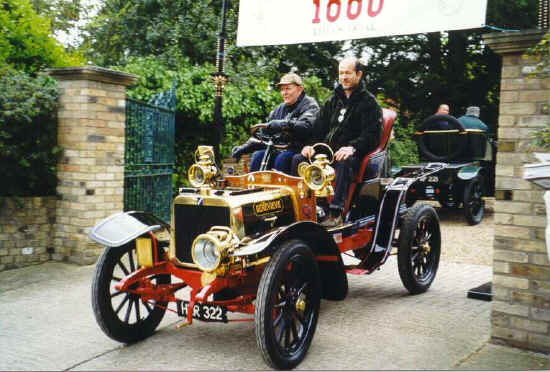 |
Where
is "Genevieve" Today?
Right
where you'd hope she would be! Genevieve completed the
London-Brighton Run this year.
She's pictured above in May of 2000 starting the centennial
re-enactment
of the 1900 1000-mile Trial with Howard Wilson, formerly chief engineer
at the
National Motor Museum, at the wheel
(Photo
copyright and courtesy of David Burgess-Wise)
|

The
Brighton Belle Celebrates 50 Years On The Run
November
would not be quite the same without Genevieve
by
David Burgess-Wise
Reprinted from Aston, published by the Aston Martin Heritage Trust
|
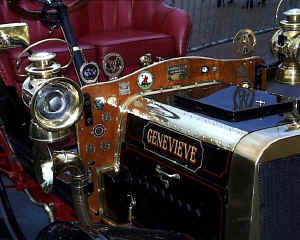 Genevieve
made only one film, but her performance changed our lives. She was almost 50
when she found international stardom, yet she still looks as good as ever nearly
half a century on. Like so many stars of her generation, she changed her name
for the silver screen to that of the patron saint of the city where she was born
in 1904. And even by motion picture standards, her discovery was bizarre, for
she was found lying naked and badly the worse for wear in a hedge down the Lea
Bridge Road in East London by a bailiff called Bill Bailey... Genevieve
made only one film, but her performance changed our lives. She was almost 50
when she found international stardom, yet she still looks as good as ever nearly
half a century on. Like so many stars of her generation, she changed her name
for the silver screen to that of the patron saint of the city where she was born
in 1904. And even by motion picture standards, her discovery was bizarre, for
she was found lying naked and badly the worse for wear in a hedge down the Lea
Bridge Road in East London by a bailiff called Bill Bailey...
|
|
...
All right, if you're one of the tiny minority who have never seen the film, I'll
come clean. Genevieve is a motor car, a twin-cylinder 10/12 hp Darracq built in
Paris in 1904...
'But,'
you're saying, 'I own a 1966 DB6 Vantage, so why should I be concerned about a
1904 Darracq named Genevieve with non-original body work which appeared in a
film launched in 1953? Lionel Martin owned many makes of car, but never a
Darracq -- what relevance does it have to my hobby?'
Well,
for a start, no less an authority than the National Motor Museum declares that
'Genevieve is the mascot of the old car movement.' Why? Because if it hadn't
been for that Darracq, tens of thousands of people probably wouldn't have a
hobby. Before Genevieve starred in that film, 35-year-old cars interested no
more than a handful of connoisseurs and eccentrics. Very few people bothered to
restore old cars and few garages would have anything to do with them.
|
| |
|
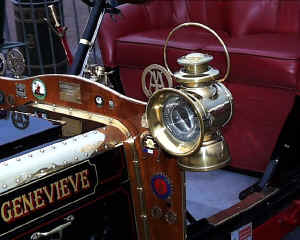 Genevieve
changed all that and owning old cars became socially acceptable. Even though the
film had been made by a South African, it precisely captured that peculiarly
British enthusiasm for ancient machinery -- and the peculiarly British
characters who collected old cars. Genevieve
changed all that and owning old cars became socially acceptable. Even though the
film had been made by a South African, it precisely captured that peculiarly
British enthusiasm for ancient machinery -- and the peculiarly British
characters who collected old cars.
Centered
on the London -- Brighton Veteran Car Run, which had been held since 1927 to
commemorate the raising of the speed limit from 4 mph to 12 mph in 1896,
Genevieve played to packed houses round the world and proved the best ambassador
the antique car movement ever had.
|
|
It
transformed the ownership of old cars from a minority interest into a major
international hobby and made the Brighton Run the world's biggest motoring
event. It also ensured the preservation of cars not yet born when they in turn
became hold an interesting. The historic vehicle movement owes a tremendous debt
of gratitude to Genevieve.
The
moment of her discovery deserves recording: Bailiff Bailey was on his way to
serve a court order one day late in 1945 when, looking at the document he was
about to serve rather than where he was going, he barked his shin on the rusty
dumbiron of an ancient car that was sticking out of a hedge. As a collector of
ancient motorcycles, his curiosity was aroused. Realising that the derelict car
was a veteran twin-cylinder Darracq, he peered through the hedge to find what
looked like a sunken builder's dump, strewn with heaps of rubble, old bricks,
chimney pots and doors, from most of which protruded an ancient wheel or a
steering column.
|
| |
|
 He
passed on the intelligence to two friends, Bill Peacock and Jack Wadsworth, who
collected veteran and vintage cars: they investigated, and eventually located
the owner of the yard living in the scullery of an adjoining house which was
otherwise filled with junk. He
passed on the intelligence to two friends, Bill Peacock and Jack Wadsworth, who
collected veteran and vintage cars: they investigated, and eventually located
the owner of the yard living in the scullery of an adjoining house which was
otherwise filled with junk.
After
a long period of haggling Peacock and Wadsworth bought every car in the yard --
there were 15 of them, dating from 1903 to the late 1920s, mostly lacking their
body work -- for £45, which even by the standards of the day was a bargain.
With the help of willing, if ill-prepared, friends, the cars were extricated
from the yard and trailered to Wadsworth's yard in Isleworth, Middlesex.
Wadsworth and Peacock kept the best of their purchases, a 1903 Sunbeam and a
1903 Argyll, for themselves, and sold off the remainder to friends.
|
| |
|
The
Darracq from the hedge had been robbed of everything removable by the local
children, but there was a second Darracq chassis of similar age which was
complete but badly rusted. Both cars were sold to an acquaintance named Peter
Venning for £25 and he began dismantling them to make one good car out of the
two chassis. The bits were taken to a workshop near Kew Bridge, stripped,
cleaned and reassembled and put into working condition.
Front
wheels of the correct size were found on an old model T Ford on a chicken farm
in the shadow of Dunstable Downs and, when Venning got married in 1949 and moved
to the village of Takely in Hertfordshire, the rolling chassis was towed to a
new home in a shed at Canons Farm at nearby Start Hill. Here, old farmer Cannon
proved to have an old gig made out of a veteran car body lying in the barn and,
as luck would have it, the body fitted the Darracq chassis precisely.
This,
however was the point at which Venning decided, like so many restorers since,
that "I had to acknowledge that I did not possess the facilities or the
money to continue and complete a proper and worthwhile restoration," and
advertised the incomplete restoration in Motor Sport for £35.
|
| |
|
It
was bought by Uxbridge Ford dealer Norman Reeves, who already had for veterans
in his workshop -- two Benzes, a De Dion-Bouton and a Dürkopp -- and handed it
over to his mechanic Charlie Cadby. The tubular radiator on the Darracq was only
fragmentary, so Reeves borrowed a 1904 "Flying Fifteen" from a near
neighbor and copied its radiator, even though it was the wrong pattern for the
little 10/12 hp.
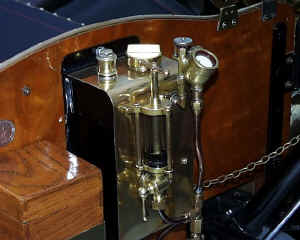 In
1949, the old Darracq was ready to rally, and Reeves, who had nicknames for most
of his cars, christened it 'Annie'. The car proved so reliable that in 1950 was
taken on a veteran rally to Le Torquet, and that year 'Annie' completed her
first London -- Brighton run. In
1949, the old Darracq was ready to rally, and Reeves, who had nicknames for most
of his cars, christened it 'Annie'. The car proved so reliable that in 1950 was
taken on a veteran rally to Le Torquet, and that year 'Annie' completed her
first London -- Brighton run.
Thinking
the old gig body lacked style, Reeves got Charlie Cadby to build up the back of
the bench-type seat into a more elaborate 'tulip' style and added a rear boot.
He also tried to improve the steering by altering the camber angle but found
that, while the car was wonderful at going round corners, it became hopeless in
a straight line!
|
| |
| In
1952 South African-born film producer Henry Cornelius, best known for films like
Passport to Pimlico and Hue and Cry, approached the Veteran Car
Club with a script about a fictitious London-Brighton Run and asked for its
help. Wary at first that Cornelius simply wanted to make fun of their hobby, the
Club read the script and softened. But though Cornelius wanted his main
characters to drive British-built cars, not one owner was willing to lend the
Wolseley or Humber that had been specified for the hero, Alan McKim, or the
Lanchester required for his friend and rival Ambrose Claverhouse.
|
| |
|
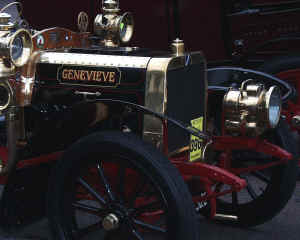 Finally,
Norman Reeves stepped forward and offered 'Annie' for the starring role: his
friend Frank Reese then lent his Dutch-built Spyker -- which had once shared
that yard in Uxbridge with the Darracq -- for Claverhouse's car. Along with
'Annie', who had to change her name to 'Genevieve' for the film, Reeves offered
the services of his mechanic Charles Cadby for the duration of the film, shot
between September and November, with the real-life 1952 Brighton Run being
filmed at the end to add authenticity. Finally,
Norman Reeves stepped forward and offered 'Annie' for the starring role: his
friend Frank Reese then lent his Dutch-built Spyker -- which had once shared
that yard in Uxbridge with the Darracq -- for Claverhouse's car. Along with
'Annie', who had to change her name to 'Genevieve' for the film, Reeves offered
the services of his mechanic Charles Cadby for the duration of the film, shot
between September and November, with the real-life 1952 Brighton Run being
filmed at the end to add authenticity.
Cadby
had to perform more than mechanic's duties, for when filming started it was
discovered that John Gregson, who played Alan McKim, was unable to drive, and
had to be coached by Charlie -- and his co-star, Dinah Sheridan, cast as McKim's
long-suffering wife Wendy!
|
| |
|
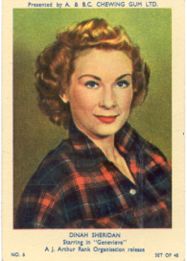 Miss
Sheridan, now living in California, recalls 'Although he was the
"owner" of the main character, the whole story being about the annual
journey from London to Brighton, John couldn't drive! I spent the whole film
time trying not to be seen giving him instructive help out of the side of my
mouth. At the end of the film he could have taken his test on Genevieve, but he
still couldn't drive a modern car.' Miss
Sheridan, now living in California, recalls 'Although he was the
"owner" of the main character, the whole story being about the annual
journey from London to Brighton, John couldn't drive! I spent the whole film
time trying not to be seen giving him instructive help out of the side of my
mouth. At the end of the film he could have taken his test on Genevieve, but he
still couldn't drive a modern car.'
The
film opened on 27 May 1953 -- Coronation Year -- at the Leicester Square
Theatre, and its gentle humor centered around the Brighton run and a subsequent
race back to London by the two protagonists with Genevieve as the prize, caught
the public imagination.
|
| |
|
The
credits, maybe, said it all: 'Any resemblance between the department of the
characters and any Club members is emphatically denied -- by the Club.'
Its
success was repeated all round the world: in Colorado the local Horseless
Carriage Club staged a run from Denver to a nearby town named Brighton and in
Melbourne the film ran continuously for months. One old lady attended every
matinee for 13 weeks and was eventually awarded a free pass by the management.
|
| |
 The
secret of the film -- voted top comedy of Coronation Year -- was that made
enthusiasts smile at themselves while showing the public what fun old cars could
be. Former Veteran Car Club secretary Elizabeth Nagle-Turnbull remarked: 'Maybe
the fiction and the fact they bear only a remote resemblance to each other;
maybe the world's audiences wonder where the one begins and the other ends!' The
secret of the film -- voted top comedy of Coronation Year -- was that made
enthusiasts smile at themselves while showing the public what fun old cars could
be. Former Veteran Car Club secretary Elizabeth Nagle-Turnbull remarked: 'Maybe
the fiction and the fact they bear only a remote resemblance to each other;
maybe the world's audiences wonder where the one begins and the other ends!'
|
| |
|
Whatever
the reason, with her two-seat bodywork, flared front wings and twinkling
brasswork, Genevieve came to epitomise the typical veteran car to the general
public, and her image appeared on every conceivable type of souvenir.
Despite
appalling weather, record crowds turned out to watch her in the 1953 Brighton
Run, in which she was driven by another hero of the hour, the Dutch rally driver
Maurice Gatsonides, winner of that year's Monte Carlo Rally in a Ford Zephyr.
(For Aston-philiacs, that charming gentlemen "Gatso", sadly better
remembered for his invention of the now ubiquitous police road camera, won his
class in the 1955 Monte with a DB 2/4.)
|
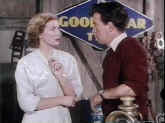 People
who previously wouldn't have considered owning an old car started looking for a
veteran of their own. Obviously, there weren't enough Brighton run cars to go
around and prices rocketed accordingly. However, the enthusiasm Genevieve had
engendered was translated into a general interest for old cars of all kinds.
Where one generation was inspired to collect veteran and vintage cars,
succeeding generations found nostalgia for the cars they had grown up with. People
who previously wouldn't have considered owning an old car started looking for a
veteran of their own. Obviously, there weren't enough Brighton run cars to go
around and prices rocketed accordingly. However, the enthusiasm Genevieve had
engendered was translated into a general interest for old cars of all kinds.
Where one generation was inspired to collect veteran and vintage cars,
succeeding generations found nostalgia for the cars they had grown up with.
|
| |
|
Sadly,
all that attention got too much for Norman Reeves (who became known as 'Mr.
Genevieve') to bear. At the end of filming he offered Genevieve to Henry
Cornelius and his wife for £450, but, as Margery Cornelius recalled in 1992:
'We had no suitable garage for her and anyway we had no idea that the film would
make her so famous. We had also invested our last penny in making the film.'
Then
in 1956 Norman Reeves tried to sell Genevieve to the Mayor of Brighton, the town
she had done so much to publicise, but without success. The asking price of £1200
had quite a bit to do with it!
|
| |
|
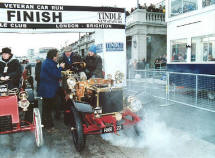 Finally,
in 1958 he entered Genevieve in the Australian Blue Mountains Rally, and then
loaned her to New Zealand enthusiast George Gilltrap for his car museum at
Rotorua. Eventually Gilltrap bought Genevieve from Reeves, and when he was
presented with an excessive demand for import duty for her he simply shifted his
museum -- lock, stock and 1904 Darracq -- to Australia. Finally,
in 1958 he entered Genevieve in the Australian Blue Mountains Rally, and then
loaned her to New Zealand enthusiast George Gilltrap for his car museum at
Rotorua. Eventually Gilltrap bought Genevieve from Reeves, and when he was
presented with an excessive demand for import duty for her he simply shifted his
museum -- lock, stock and 1904 Darracq -- to Australia.
George
Gilltrap died in 1966, but Genevieve remained in the possession of the Gilltrap
family until 1989, when she was sold for a record £285,302 to Paul Terry, who
showcased the old Darracq in his Esplanade Extravaganza car museum in Albany,
Western Australia.
|
| |
| Mr.
Terry undertook a comprehensive £40,000 restoration of Genevieve, taking the
enlightened decision -- despite advice to the contrary from the purists of the
Veteran Car Club who, if the truth be told, were still a teeny bit jealous of
Genevieve's success and whispered (wrongly) that she had actually been born in
1905, so was too young for the Brighton Run -- to maintain her in the condition
in which she had starred in that epochal film rather than fit a replica 1904
type "O" radiator.
|
| |
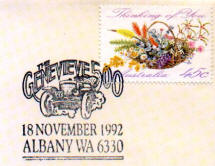 Following
a detailed restoration, Genevieve was readied for a 500 km charity run bearing
her name, in which Paul Terry was to be accompanied by Dinah Sheridan, last
survivor of the four human stars of the film, but, in the run-up to that event
Terry was tragically killed in a helicopter crash. 'A great shock and sorrow,'
says Dinah Sheridan. 'The only good result was that it brought Genevieve back to
England.' Following
a detailed restoration, Genevieve was readied for a 500 km charity run bearing
her name, in which Paul Terry was to be accompanied by Dinah Sheridan, last
survivor of the four human stars of the film, but, in the run-up to that event
Terry was tragically killed in a helicopter crash. 'A great shock and sorrow,'
says Dinah Sheridan. 'The only good result was that it brought Genevieve back to
England.'
Link to pictures of the "Genevieve 500" |
| |
|
In
November 1992 she successfully completed the Brighton Run after an absence of 36
years before being sold at auction by Robert Brooks to Evert Louwman, whose
Dutch National Motor Museum is Europe's oldest private antique car collection.
Based in England much of the time, Genevieve is once again a regular competitor
in the Brighton Run, performing, if anything, with even greater gusto then in
the 1950s.
|
| |
|
So,
whatever old car you drive, take time out on the first Sunday in November to
join the thousands lining the Brighton Road to watch the veterans go by -- and
raise your hat to Genevieve, the lady who made it all possible, and who will
celebrate a notable anniversary -- it is 50 years since her first outing to
Brighton!
With special thanks
to Dinah Sheridan, Bill Peacock, Peter Venning, Robert Brooks, Elizabeth
Nagle-Turnbull, Evert Louwman, G.R.E. Gregory.
Reprinted
with the kind permission of the Aston-Martin Heritage Trust;
Special thanks to
David Burgess-Wise and the late Walter Hayes.
Links
to:
Aston Martin Heritage
Trust
Aston Martin Owner's Club
|

Genevieve Revived
Reprinted
from Classic and Sports Car, June 1991
(Appears here 'as published.'
This article incorrectly refers to Genevieve as a 1905 model.
A footnote about the
'dating' of Genevieve is available here.) |
| |
|
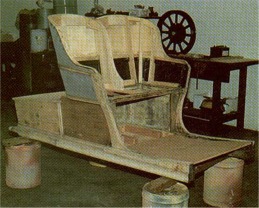 The 1905
Darracq "Genevieve," star
of the 1953 film of that name, is currently being restored in Australia --
but not to its original 1905 form. The 1905
Darracq "Genevieve," star
of the 1953 film of that name, is currently being restored in Australia --
but not to its original 1905 form.
The car is owned by Australian businessman
Paul Terry, who intends it to be the centerpiece of a classic car and art
gallery complex he is building in the Western Australia town of Albany. Terry bought "Genevieve" at auction in 1989 for 285,302 pounds,
a record price in Australia for a pre-1919 vehicle.
After
years of hard use, though, the Darracq was in a sorry state when brought
back to Albany. "It sounded like a bag of bolts, and there was so
much play between 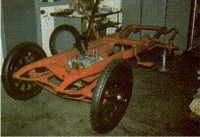 the engine and the back wheels that when you let your foot off the clutch you'd almost have to wait for everything
to take up
before you had forward motion," says Ken Taylor, responsible for the
restoration. the engine and the back wheels that when you let your foot off the clutch you'd almost have to wait for everything
to take up
before you had forward motion," says Ken Taylor, responsible for the
restoration.
New gears have had to be cut for both the
gearbox and the back axle, and the badly cracked engine block, already
repaired in the past, has had to be welded up again.
|
| |
|
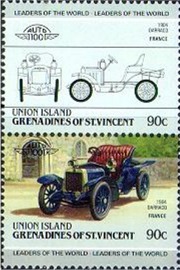 During the restoration, to be completed by
the autumn an estimated cost of 40,000 pounds, the car will not be
returned to its authentic state -- it will remain as it appeared in the
film. Equally, there is no intention of using a 1904 chassis and steering
box bought with "Genevieve" to re-create the car as a 1904 model eligible for the London to Brighton run. During the restoration, to be completed by
the autumn an estimated cost of 40,000 pounds, the car will not be
returned to its authentic state -- it will remain as it appeared in the
film. Equally, there is no intention of using a 1904 chassis and steering
box bought with "Genevieve" to re-create the car as a 1904 model eligible for the London to Brighton run.
Thus
the Darracq will retain the built-up body with deep seat buckets incorrectly paneled in aluminum, and it will keep its 12-spoke wheels
rather than being returned to the correct 10-spoke rims.
"We really only agonized over keeping
the car as 'Genevieve' for five minutes. It wasn't a big decision,"
says Terry. "The car is simply far more important
as 'Genevieve' than as a 1905 Darracq. It's the most important veteran car
in the world." |
|
This argument is defended by Michael Ware,
curator of the National Motor Museum at Beaulieu. "A person restoring such car has a
choice. He can restore it to 'as it was when new' or how it was at a later
stage in its life -- and a lot of cars have spent longer in a later guise
than in their original form. I think it's almost enlightening to hear of
someone taking this restoration route."
John Mitchell, a past president and past
chairman of the Veteran Car Club, agrees: 'As
"Genevieve," it was an absolute
milestone in the old car movement. It put us on the map. But it was a miserable little motor
car, a gutless wonder. Its fame was as "Genevieve" in the film, and I
think it should retain that identity. That's why it was famous, not as a
miserable little Darracq."
This
seems a good place to point out that some of the opinions expressed on this site
are most definitely not those of the web site maintainer! |

|
Comments
from Antony Davies
|
| |
|
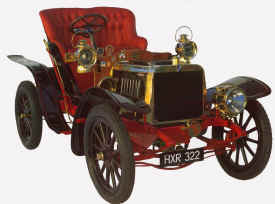 Antony Davies of
Wemyss Fine Art
Auctioneers Australia was kind enough to provide a spectacular image
(courtesy Paul Terry International) which shows Genevieve just after her 1991
restoration in Western Australia. Again, there is discussion about dating the
car as 1904 or 1905, and Genevieve has been authoritatively dated as 1904 and
thus fully eligible for the London-Brighton Run. Antony Davies of
Wemyss Fine Art
Auctioneers Australia was kind enough to provide a spectacular image
(courtesy Paul Terry International) which shows Genevieve just after her 1991
restoration in Western Australia. Again, there is discussion about dating the
car as 1904 or 1905, and Genevieve has been authoritatively dated as 1904 and
thus fully eligible for the London-Brighton Run.
|
|
Antony Davies:
I knew
Genevieve for many years whilst dealing with the Gilltrap family in Queensland, George Gilltrap having purchased the car
after its use in the film.
He took it to New Zealand. However, he found,
in buying cars from around the world for his collection there, that the New Zealand
government would not give import duty reductions for veteran cars, and in
annoyance or frustration, George moved his business, family and cars to
Australia.
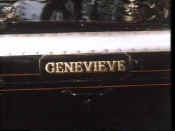 George died some years ago and on the later
death of his wife, the balance of their collection was sold at auction in Queensland.
Genevieve went to a businessman named Paul Terry, who had founded a financial services
company called Monitor Money in Sydney and subsequently sold his business to retire
to
Albany, an old whaling port at the south-western most tip of Western Australia.Genevieve was in drivable but run-down condition at the time
Terry bought her. I subsequently bought many cars for Paul who told me
that he considered his purchase of Genevieve 'a bargain.' George died some years ago and on the later
death of his wife, the balance of their collection was sold at auction in Queensland.
Genevieve went to a businessman named Paul Terry, who had founded a financial services
company called Monitor Money in Sydney and subsequently sold his business to retire
to
Albany, an old whaling port at the south-western most tip of Western Australia.Genevieve was in drivable but run-down condition at the time
Terry bought her. I subsequently bought many cars for Paul who told me
that he considered his purchase of Genevieve 'a bargain.'
|
| |
 Paul and his wife built a spectacular home, a fine luxury
hotel -- The Esplanade Hotel, and a car museum in Albany. Paul sponsored a variety of old car events in Western Australia. Paul and his wife built a spectacular home, a fine luxury
hotel -- The Esplanade Hotel, and a car museum in Albany. Paul sponsored a variety of old car events in Western Australia. During restoration of Genevieve, which
cost substantially more than Paul had paid to acquire the car, it was
noted that the car
could only be dated as a 1905 car, as there were not enough 1904 parts on it to qualify as an
'04.
|
| |
| Both the Veteran Car Club of Australia and Great Britain were
petitioned about this but neither would allow a 1904 dating
certificate. So, the car was not eligible for a London to Brighton Run however a concession was
eventually given to Paul to include the car as a special guest on the 40th anniversary of the film -- a trip which it regrettably could
not make. |
| |
| Various 1904 parts were sourced from around the world to allow
the option of rebuilding it as a 1904 for the purpose of Brighton Runs in the future if desired, and these parts are still in Albany with the restorer when I last saw them. The car was well-restored in sympathy for
its history, and made to look as close as possible to its appearance in the film. They spent a lot of time trying to perfect the gearbox (a poor
design to start with), and sourcing correct bolts and nuts, and smaller ancillary components. |
| |

Paul had a private airport with a variety of fast aircraft,
his other passion, and I was in Albany with him in 1993 planning the sale of all
his post-World War I vehicles so he could concentrate on veteran cars to compliment Genevieve.
Tragically, a week later, he was killed in a freak accident in
America, during his first solo helicopter flight.
|
| |
| I subsequently sold all of his vehicles
at auction in Perth, Western Australia, on 12th December 1993, but Genevieve was sent to
London and sold there for about 150,000 UK Pounds Sterling to the Dutch National Motor
Museum, which also own the Spyker from the film. They still have the car. It is a delightful little car and whilst it never did run
particularly well, it gave many people their enthusiasm for veteran motoring.
|
| |
| ( Antony Davies' father owned one of
the original "Chitty Chitty Bang Bang" autos. Three of these were built using Rolls-Royce P3 chassis and replica
boat deck bodies in Kent, England in about 1965. Only one had an engine; they made three so that filming in France and around England
would not be delayed waiting for the car. The car that came to Australia and belonged to Antony's father in the 1970s had an Australian
Holden engine and Antony recalls that the large car drove "like a crazy fire-engine". Mr. Davies has been most kind in
providing additional information about Genevieve, and his valuable additions to this site are gratefully acknowledged.) |
| |

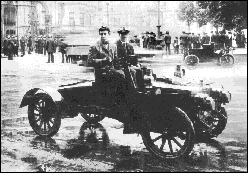 The
Curious Mr. Darracq The
Curious Mr. DarracqThe
French-built Darracq auto was created by Alexander
Darracq, a man who didn't like driving cars or being driven in
them. Born in Bordeaux, France, of Basque parents, Darracq
preferred making bicycles. But in 1896, he felt compelled to develop an electric car,
which he later dismissed as being "worthless." After running
into financial problems, his company was reformed with British capital,
ultimately merging with Talbot and then Sunbeam before expiring in
1939.
Click
here to listen to David Burgess-Wise on Alexander Darracq
|

|
